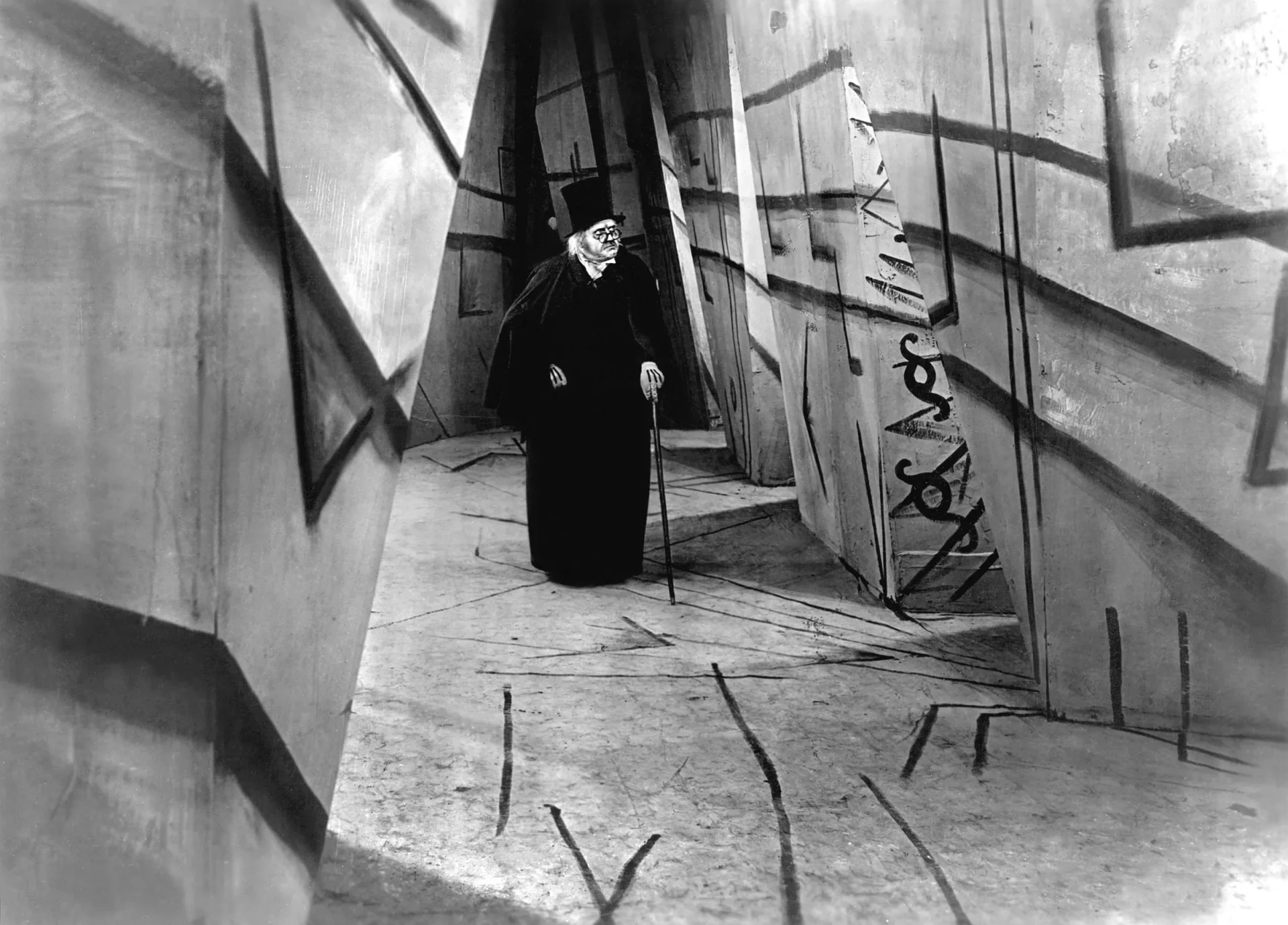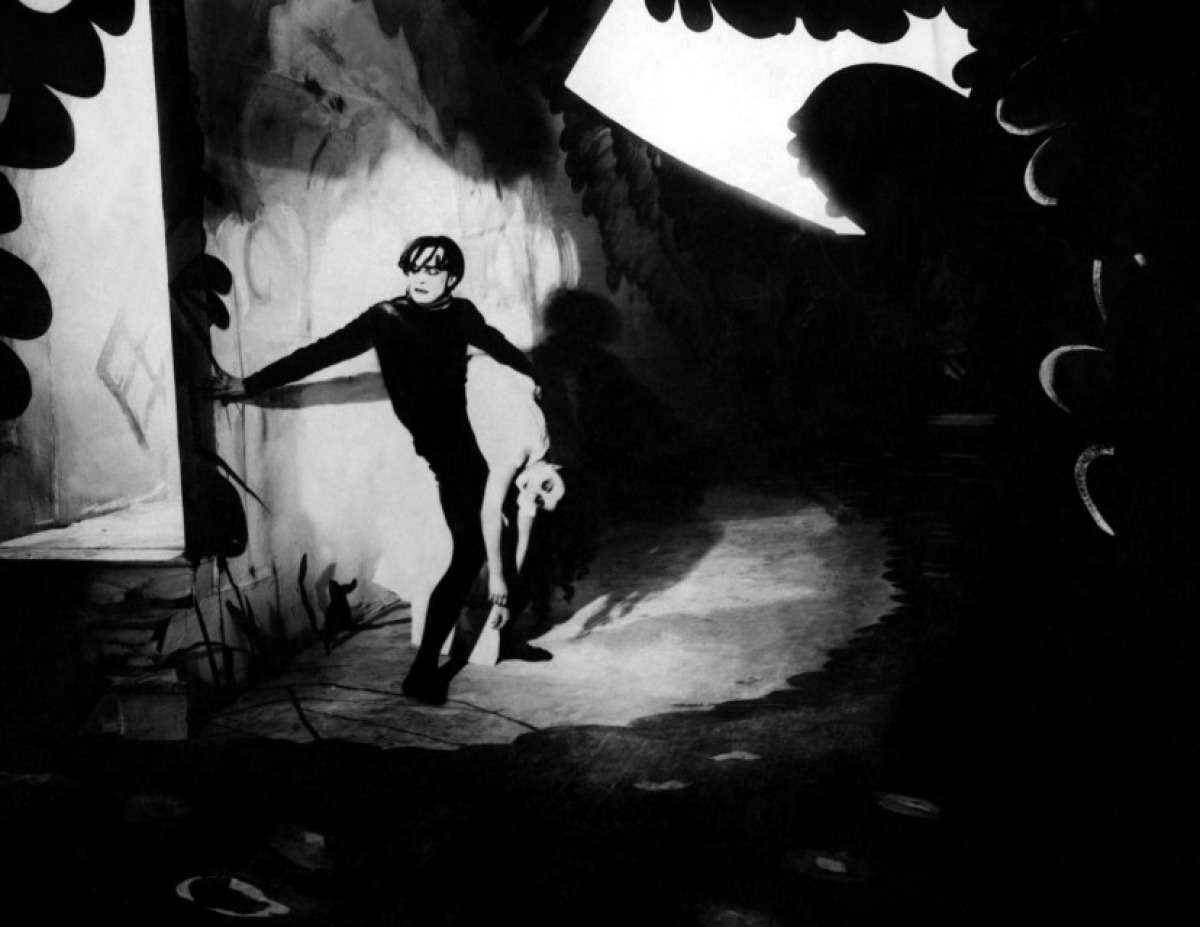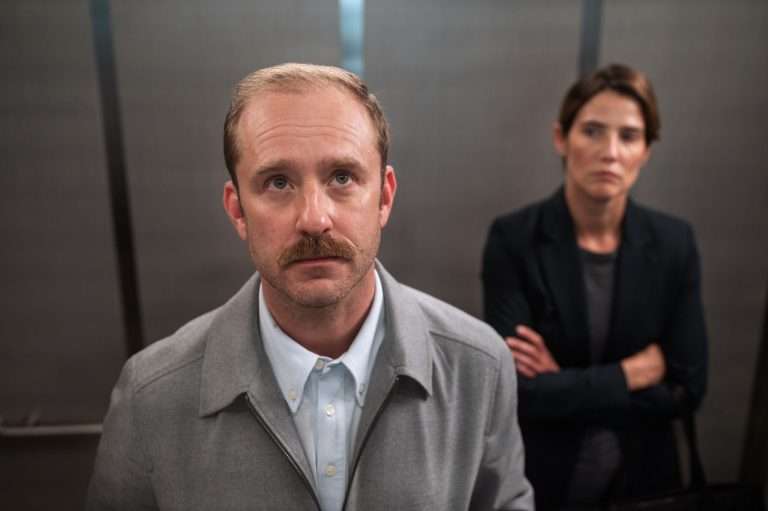Robert Wiene’s “The Cabinet of Dr. Caligari” communicates a dyspeptic authority and a reclamation of order from the authoritarian rule. Wiene’s narrative has a commonsensical hero who, by the end, is proven to be delusional, a subservient but equally heinous somnambulist, and an authoritative figure who is also shown to be benign. The circumambient and often riddling logic of the narrative establishes a strong case against authority, but, in the end, it pins the blame on the seemingly commonsensical man for his nonsense.
The visual style, with strange designs and dissolving perspectives, evokes the disquieting ripples of a world ready to explode or dissolve.
The Cabinet of Dr. Caligari (1920) Plot Summary & Movie Synopsis:
The film opens with Francis, a young fellow, sitting in a park with an old companion. The old man recounts the horrors of being chased by spirits throughout his life. The man is cut short by the ghostly arrival of a woman in white, taking a stroll in the park. The woman is Jane, Francis’ beloved. Francis begins narrating his experiences, which he claims to be stranger than those of his old companion. Thus, the story begins.
The mystery man at the fair
The story is set in the little German town of Holstenwall, where Francis and his friend, Alan, live. One day, the town witnesses the arrival of a boisterous fair. One mysterious man, Dr. Caligari, arrives at the town clerk’s office to obtain a permit for his spectacle. The town clerk meets his appeal for permission to exhibit his spectacle– a somnambulist– with a tart reaction. The next day, the crowd at the fair greets Cesare, the somnambulist, with the loudest of cheers. The same night, the haughty town official gets murdered under strange circumstances.
The fair continues despite the murder having no ramifications on the footfall. Francis and Alan arrive at the fair and watch with awe as Cesare, the somnambulist, straightens up and announces himself out of his coffin. Caligari’s swaying address to the crowd, claiming that Cesare has the power to know the past and see the future, moves Alan. Alan becomes confident and asks Cesare to make a prediction on the length of his life. Cesare prophesies that Alan will live till the break of dawn. After a night out with Francis and Jane, whom both Alan and Francis love, Alan retires to his room to sleep. At dawn, Alan is found dead in the same manner as the town clerk.
Francis is sure that the death has followed the somnambulist’s prophecy. With the help of Jane’s father, Francis obtains a search warrant and storms into Caligari’s wagon. They ask Caligari to lift the trance that shrouds Cesare. Right at this moment, Francis gets a summon from the police that proclaims that the murderer has been caught. Francis and Jane’s father arrive at the police station for the conviction of the serial murderer. However, the man denies his involvement.
If Cesare is in the wagon, then who kidnapped Jane?

Francis is still unconvinced of Caligari’s innocence and continues to spy on him. As he spies on him and Cesare through a window on the wagon, the real Cesare is out to hunt Jane. He whisks her away after scaring her with a dagger. After a while, Jane’s father chases the kidnapper with his people. Cesare is forced to drop Jane but dies abruptly in the end.
Jane insists that it was Cesare. However, Francis has doubts since he has watched him sleeping in the wagon for hours. Francis checks up on the man taken in as the serial murderer, but he has been chained for days. Francis arrives at Caligari’s door again with the police to lift the lid off the mystery. It turns out that the coffin contains a dummy that is an exact doppelganger of Cesare. Caligari manages to bolt out of the scene. He keeps running until he arrives at a mental asylum. Francis follows him and arrives at the mental asylum. He asks around about Caligari. But the name does not ring any bell among the staff. They advise Francis to approach the director and escort him to his cabin. To Francis’ shock, the director is no one else but the devil himself– Caligari.
Caligari’s truth
That night, as Caligari is sleeping, Francis and members of the asylum skim through the books in Caligari’s cabin. There, they find evidence of a vast web spread out by Caligari testifying his misdeeds. They find one of the books that accounts for an eighteenth-century mystic, Caligari, who toured the fairs of numerous villages in Northern Italy. As a companion, he kept Cesare, a somnambulist. He hypnotized and compelled Cesare to carry out his crimes.
When Cesare was on the loose killing people, Caligari deftly substituted him with a wax figure to deceive the state authorities. A horrifying account from the director’s diary testifies that his obsession with Caligari gained fruition when a somnambulist was entrusted to his care. The director endowed himself with Caligari’s identity and meddles with the somnambulist’s psyche in the same way as Caligari. To unmask the director, Francis brings in Cesare’s dead body. This sends Caligari into shock, and he is ultimately forced to wear a straitjacket and be confined.
The Cabinet of Dr. Caligari (1920) Movie Ending Explained:
How does the figure of Caligari stand for the invincible postwar German authority?
Francis’ story ends, and we are drawn back to the present. The park is revealed to be the park of a mental asylum, and Francis is revealed to be a madman. All this while we are made privy to a madman’s ramblings. After his narration ends, Francis and his partner return to the asylum. It seems to be the same asylum as Francis’ story.
Miserable-looking figures populate the asylum. Francis points to Cesare, who is in the corner, lost in his own world and caressing a little flower. The director— an almost unwavering fatherly figure —arrives. Francis agitatedly attacks him, for he is certain that the director is Caligari, the character from his imagination but dangerous on par. He tries to loosen the grip of the medical attendants and escape.

Ultimately, he is carried to a confinement room where the director puts on his horn-rimmed spectacles to examine him. This brings back the image of Caligari from Francis’ story. He removes his spectacles and, in a benign demeanor, says that he seems to know the diagnosis of the mental illness that debilitates Francis. Now that he understands the patient’s case, he will be able to heal him.
The Cabinet of Dr. Caligari (1920) Movie Themes Analysed:
The most influential and persuasive dissection of Robert Wiene’s “The Cabinet of Dr. Caligari” is offered by film critic Siegfried Kracauer in his “From Caligari to Hitler: A Psychological History of the German Film.” For Kracauer, the figure of Caligari, with the backdrop of the formation of the Weimar Republic, stands for an inexhaustible fount of brutal authority and power. Cesare, then, is a product of servitude to this authority. In a way, the film forebodes the desire for a tyrant that is transmuted and culminates in the arrival of Adolf Hitler in the world scene. The complete submission of the somnambulist to Caligari’s whim presses the idea of the complete submission to Hitler’s Nazi Party.
The original story of Hans Janowitz and Carl Mayer was a direct statement against the authority. Weine’s, however, dissipates it to a madman’s rambling. This appears in the form of a framing story– the essence is tucked inside and bookended by a flashback. According to Kracauer, the endemic of framing stories on screen during this time of postwar years reflected the cushioned retreats by the masses, which made it incapable of questioning authority. It underscored the psychological experiences that were predominant during this time. At this time, Caligari’s confinement, which appears in Francis’ fantasy, is a metaphor for the mass’s desire for the dissipation of authority.
The askew mis-en-scene that appears and reappears is a cornerstone of Expressionism, of which the film is a progenitor. They symbolize the treacherous subconscious that lingers beneath the collective consciousness of the postwar Germans. In this sense, the expressionist setting, the device of the framing story, and the narrative of the authority make for a profoundly disturbing but politically and psychologically profound work.
“The film reflects this double aspect of German life by coupling a reality in which Caligari’s authority triumphs with a hallucination in which the same authority is overthrown. There could be no better configuration of symbols for that uprising against the authoritarian dispositions which apparently occurred under the cover of a behavior rejecting uprising”. (Kracauer, 1947)
The film’s constant vacillation between authority and insanity or chaos compels the viewers to choose between the resurrection of power and the enervating hullabaloo of the fairground. For Thomas Elsaesser, Caligari asserts and repeats the same authoritarian display of which he has been a victim, the incipience being the incident with the town clerk.







